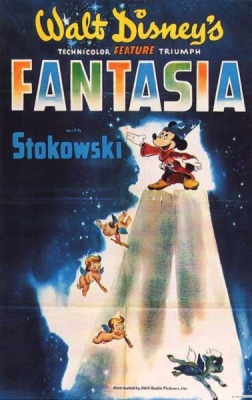 So I’m in error. The
Reluctant Dragon was released in 1941 and Fantasia was released in 1940. I should have watched Fantasia first. I’m also renaming the
Edge of Enjoyment to the Edge of Satisfaction.
So I’m in error. The
Reluctant Dragon was released in 1941 and Fantasia was released in 1940. I should have watched Fantasia first. I’m also renaming the
Edge of Enjoyment to the Edge of Satisfaction.
Anyway, Fantasia
released November 13, 1940 is another hybrid film consisting of eight animated segments set to classical music. Leopold Stokowski directs the Philadelphia
Orchestra and Deems Taylor introduced each segment as the Master of Ceremonies.
The film was designed as a comeback for Mickey Mouse after he had declined in
popularity and the Silly Symphonies shorts
grew in theirs. While it was Disney’s first actual flop, it was rereleased in
1969, 1977, 1982, 1985, and 1990.
The film opens with the orchestra gathering and tuning their
instruments in half-light, half-shadow against a blue background. Deems Taylor
enters the stage and introduces the program.
Bach’s Toccata and
Fugue in D Minor is first, portraying live action shots of the orchestra
illuminated in blue and gold, backed by superimposed shadows, fade into
abstract patterns. Animated lines, shapes, and cloud formations reflect the
sound and rhythms of the music.
Next is Tchaikovsky’s Nutcracker
Suite. Selections of the ballet suite are set to the changing of the
seasons with a variety of dances by fish, fairies, flowers, mushrooms and
leaves.
Then, it’s Paul Dukas’ The
Sorcerer’s Apprentice, where Mickey Mouse is the young apprentice of sorcerer
Yen Sid. He attempts to use some of his master’s magic to control the brooms
into doing his chores, but is unable to control them.
Stravinsky’s Rite of
Spring follows, presenting a visual history of Earth’s beginning’s, from
the first living creatures to the reign and extinction of the dinosaurs.
After the intermission, there is a humorous demonstration of
how sound is rendered on film, making the soundtrack a character.
Beethoven’s Pastoral
Symphony plays while an ancient Greek world of centaurs, cupids, fauns and
other mythological figures is portrayed. While gathering for a festival to
honor Bacchus, Zeus interrupts and creates a storm, throwing lightning bolts at
the attendees.
Afterwards, Amilcare Ponchielli’s Dance of the Hours plays as a comic ballet with Madame Upanova and
her ostriches, Hyacinth Hippo and her servants, Elephanchine and her elephant
troupe, and Ben Ali Gator and his troop of alligators. The finale has all of
the characters dancing together until the palace collapses.
Finally, Mussorgsky’s Night
on Bald Mountain and Schubert’s Ave
Maria play as the devil Chernabog summons evil spirits and souls from their
graves. They dance and fly through the air until the sound of an Angelus Bell
rings, signaling night changing to dawn. A chorus sings Ave Maria as a line of
robed monks walks with lighted torches through the forest and into the ruins of
a cathedral.
I can see why this initially flopped. It’s basically an
animated concert where the only thing that resembles a plot is Deems Taylor introducing
the pieces. That being said, when coming into Fantasia knowing full well what it is, the film is quite good.
Having animation alongside famous classical pieces is great.
It shows the animators’ thought processes and what they felt gave these pieces
more life. The sequence with the soundtrack as a character is no only humorous,
but also serves to show what sound looks like when it’s given a representation.
On the other hand, Fantasia is kind of long, just over two
hours. It’s the normal amount of time for a concert. I can sit through concerts
just fine and unless the story is slowly paced, length doesn’t bother me.
However, it’s more than just a concert, it’s a concert juxtaposed with
animation and it’s great. Unfortunately, every minute of those two hours
trudges by. There’s a difference between watching a concert in a concert hall
and watching it like this. It’s a great film, but it’s slow.
Final Call: a great film that juxtaposes animation with
classical pieces, but you can feel every minute of it. It won’t make the Edge
of Satisfaction, but it will be come #3.
No comments:
Post a Comment